Report: Managing Diversity and Conflict in the Workplace
VerifiedAdded on 2023/01/07
|13
|3069
|63
Report
AI Summary
This report provides a comprehensive overview of diversity management and conflict resolution in the workplace, essential for fostering a productive and inclusive environment. It begins by defining diversity management, exploring relevant legislation in Australia, and outlining effective diversity strategies. The report then delves into the complexities of conflict, identifying various types, potential causes, and warning signs. It also covers the escalation of conflicts, dangerous situations, and their impact on the workplace. Furthermore, the report details conflict management strategies, including effective communication, negotiation, mediation, seeking assistance, monitoring outcomes, and record-keeping. By addressing these key areas, the report aims to equip managers and leaders with the knowledge and tools necessary to navigate the challenges of a diverse workforce and resolve conflicts effectively, ensuring a harmonious and productive work environment.
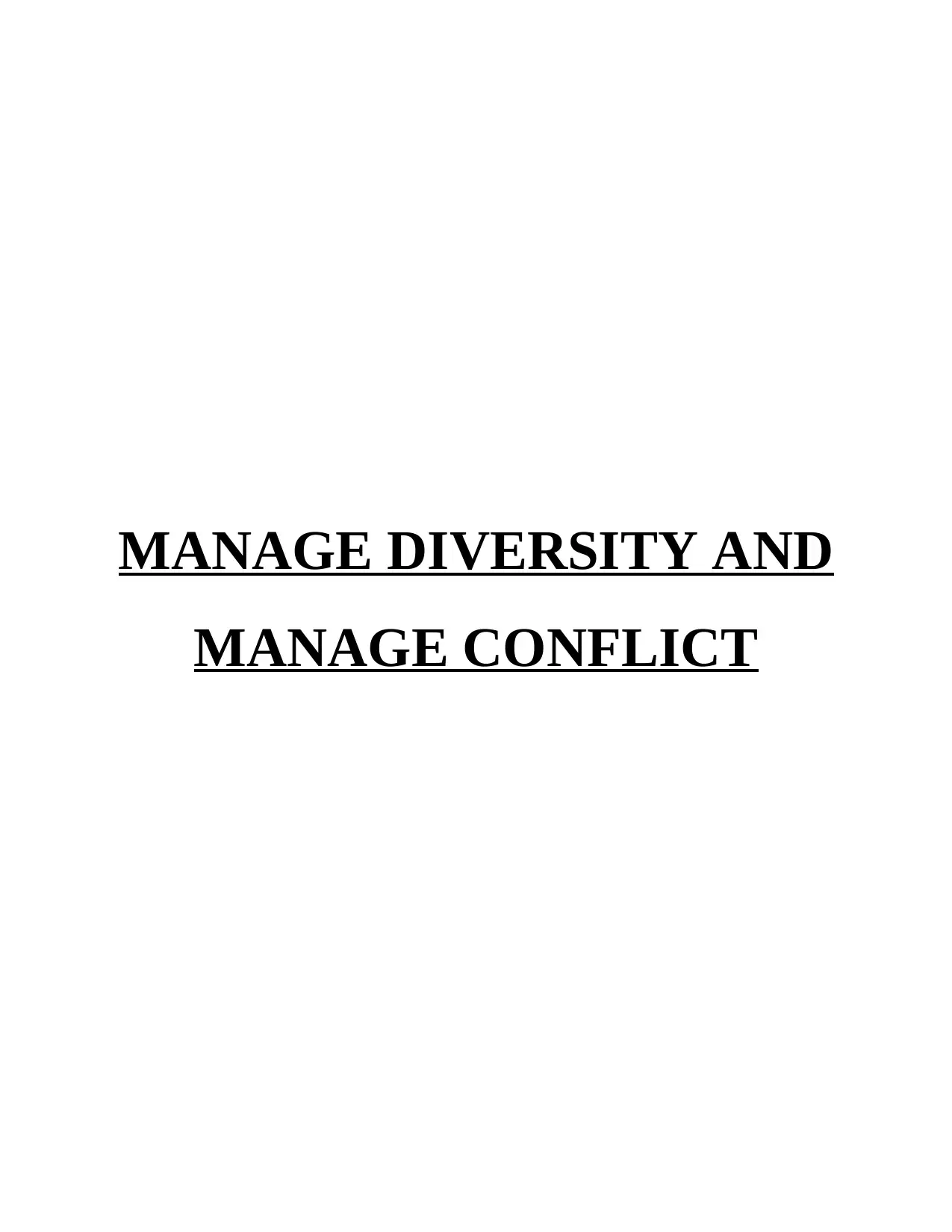
MANAGE DIVERSITY AND
MANAGE CONFLICT
MANAGE CONFLICT
Paraphrase This Document
Need a fresh take? Get an instant paraphrase of this document with our AI Paraphraser

TABLE OF CONTENTS
INTRODUCTION...........................................................................................................................3
Diversity Management.................................................................................................................3
Diversity Legislation...................................................................................................................3
Diversity Strategy........................................................................................................................4
Unresolved Issues........................................................................................................................5
Types of Conflict.........................................................................................................................5
Identifying Potential Conflict......................................................................................................6
Signs and Symptoms of Conflict.................................................................................................7
Escalating Levels of Conflicts.....................................................................................................7
Dangerous Conflict Situations.....................................................................................................8
Impact of Conflict........................................................................................................................8
Conflict Management..................................................................................................................8
Effective Communication............................................................................................................9
Negotiation and Meditation.......................................................................................................10
Seeking Assistance....................................................................................................................10
Monitoring and Reviewing Outcomes.......................................................................................10
Record Keeping.........................................................................................................................11
CONCLUSION..............................................................................................................................11
REFERENCES..............................................................................................................................12
INTRODUCTION...........................................................................................................................3
Diversity Management.................................................................................................................3
Diversity Legislation...................................................................................................................3
Diversity Strategy........................................................................................................................4
Unresolved Issues........................................................................................................................5
Types of Conflict.........................................................................................................................5
Identifying Potential Conflict......................................................................................................6
Signs and Symptoms of Conflict.................................................................................................7
Escalating Levels of Conflicts.....................................................................................................7
Dangerous Conflict Situations.....................................................................................................8
Impact of Conflict........................................................................................................................8
Conflict Management..................................................................................................................8
Effective Communication............................................................................................................9
Negotiation and Meditation.......................................................................................................10
Seeking Assistance....................................................................................................................10
Monitoring and Reviewing Outcomes.......................................................................................10
Record Keeping.........................................................................................................................11
CONCLUSION..............................................................................................................................11
REFERENCES..............................................................................................................................12

INTRODUCTION
In today’s world, organizations are becoming more and more diverse with people from
different backgrounds, cultures and nationalities (Chenhall, Hall and Smith, 2016). This provides
many opportunities to the workplace in order to bring innovation and growth by using different
skillsets which contributes in achieving the results. But it happens at a cost as conflicts are
obvious whenever organizations have diverse workforce.
Being a manager, it is my foremost responsibility to communicate effectively and respect all the
employees, analyses the problems and realize the contribution of every employee in the
workplace. This can help me in managing most of the conflicts. Whenever any conflict arises, I
must talk to each person, listen to both sides before considering someone wrong or right, asks for
solutions from everyone and then make a final decision which can make everyone satisfies
resolving the conflicts.
Diversity Management
Diversity is created by the people or group of people having vast spectrum of philosophical
and demographic differences. This deals in accepting and respecting the people varying in terms
of race, ethnicity, gender, age, religions, socio-economic status and many more factors (Pullen
and et.al.,2019). The main challenge for the diverse environment is to explore the different
people by creating a safe, positive and nurturing environment.
It does not only deals in tolerating the differences in the people but also understanding, accepting
and respecting their qualities and experiences. It sometimes results in conflicts which hinders the
performance of the employees which need to be resolved by the managers and the supervisors.
Therefore, managing diversities and conflicts go hand in hand which are must for the
organizations’ progress.
Diversity Legislation
When an organization promotes a diverse environment, it breaks various social and racial
barriers along with providing equal opportunities to every employee (Roberson, Ryan and
Ragins, 2017). It is not possible all the organizations to obey all the laws of equality but can
focus on following the laws which do not disrespect their cultures and beliefs.
3
In today’s world, organizations are becoming more and more diverse with people from
different backgrounds, cultures and nationalities (Chenhall, Hall and Smith, 2016). This provides
many opportunities to the workplace in order to bring innovation and growth by using different
skillsets which contributes in achieving the results. But it happens at a cost as conflicts are
obvious whenever organizations have diverse workforce.
Being a manager, it is my foremost responsibility to communicate effectively and respect all the
employees, analyses the problems and realize the contribution of every employee in the
workplace. This can help me in managing most of the conflicts. Whenever any conflict arises, I
must talk to each person, listen to both sides before considering someone wrong or right, asks for
solutions from everyone and then make a final decision which can make everyone satisfies
resolving the conflicts.
Diversity Management
Diversity is created by the people or group of people having vast spectrum of philosophical
and demographic differences. This deals in accepting and respecting the people varying in terms
of race, ethnicity, gender, age, religions, socio-economic status and many more factors (Pullen
and et.al.,2019). The main challenge for the diverse environment is to explore the different
people by creating a safe, positive and nurturing environment.
It does not only deals in tolerating the differences in the people but also understanding, accepting
and respecting their qualities and experiences. It sometimes results in conflicts which hinders the
performance of the employees which need to be resolved by the managers and the supervisors.
Therefore, managing diversities and conflicts go hand in hand which are must for the
organizations’ progress.
Diversity Legislation
When an organization promotes a diverse environment, it breaks various social and racial
barriers along with providing equal opportunities to every employee (Roberson, Ryan and
Ragins, 2017). It is not possible all the organizations to obey all the laws of equality but can
focus on following the laws which do not disrespect their cultures and beliefs.
3
⊘ This is a preview!⊘
Do you want full access?
Subscribe today to unlock all pages.

Trusted by 1+ million students worldwide
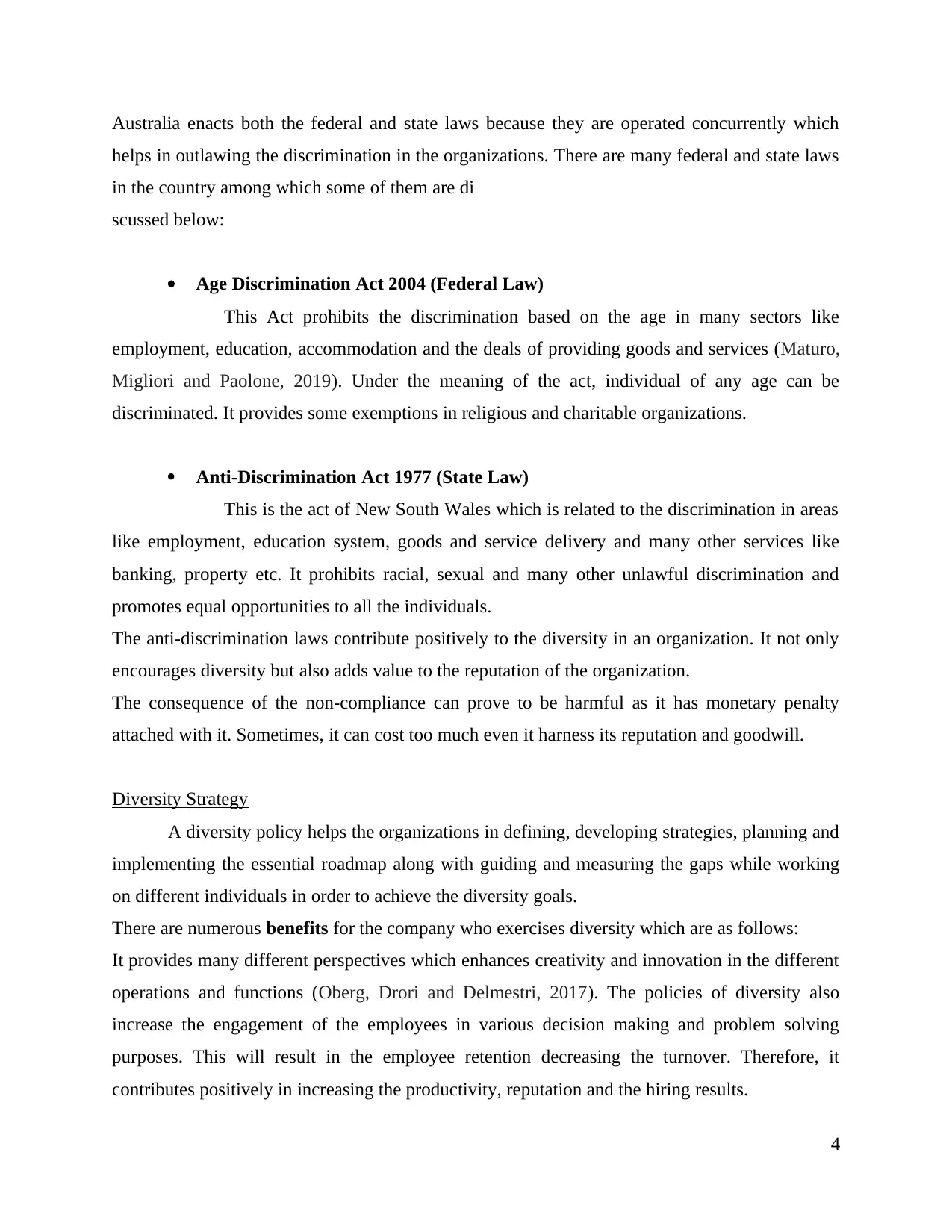
Australia enacts both the federal and state laws because they are operated concurrently which
helps in outlawing the discrimination in the organizations. There are many federal and state laws
in the country among which some of them are di
scussed below:
Age Discrimination Act 2004 (Federal Law)
This Act prohibits the discrimination based on the age in many sectors like
employment, education, accommodation and the deals of providing goods and services (Maturo,
Migliori and Paolone, 2019). Under the meaning of the act, individual of any age can be
discriminated. It provides some exemptions in religious and charitable organizations.
Anti-Discrimination Act 1977 (State Law)
This is the act of New South Wales which is related to the discrimination in areas
like employment, education system, goods and service delivery and many other services like
banking, property etc. It prohibits racial, sexual and many other unlawful discrimination and
promotes equal opportunities to all the individuals.
The anti-discrimination laws contribute positively to the diversity in an organization. It not only
encourages diversity but also adds value to the reputation of the organization.
The consequence of the non-compliance can prove to be harmful as it has monetary penalty
attached with it. Sometimes, it can cost too much even it harness its reputation and goodwill.
Diversity Strategy
A diversity policy helps the organizations in defining, developing strategies, planning and
implementing the essential roadmap along with guiding and measuring the gaps while working
on different individuals in order to achieve the diversity goals.
There are numerous benefits for the company who exercises diversity which are as follows:
It provides many different perspectives which enhances creativity and innovation in the different
operations and functions (Oberg, Drori and Delmestri, 2017). The policies of diversity also
increase the engagement of the employees in various decision making and problem solving
purposes. This will result in the employee retention decreasing the turnover. Therefore, it
contributes positively in increasing the productivity, reputation and the hiring results.
4
helps in outlawing the discrimination in the organizations. There are many federal and state laws
in the country among which some of them are di
scussed below:
Age Discrimination Act 2004 (Federal Law)
This Act prohibits the discrimination based on the age in many sectors like
employment, education, accommodation and the deals of providing goods and services (Maturo,
Migliori and Paolone, 2019). Under the meaning of the act, individual of any age can be
discriminated. It provides some exemptions in religious and charitable organizations.
Anti-Discrimination Act 1977 (State Law)
This is the act of New South Wales which is related to the discrimination in areas
like employment, education system, goods and service delivery and many other services like
banking, property etc. It prohibits racial, sexual and many other unlawful discrimination and
promotes equal opportunities to all the individuals.
The anti-discrimination laws contribute positively to the diversity in an organization. It not only
encourages diversity but also adds value to the reputation of the organization.
The consequence of the non-compliance can prove to be harmful as it has monetary penalty
attached with it. Sometimes, it can cost too much even it harness its reputation and goodwill.
Diversity Strategy
A diversity policy helps the organizations in defining, developing strategies, planning and
implementing the essential roadmap along with guiding and measuring the gaps while working
on different individuals in order to achieve the diversity goals.
There are numerous benefits for the company who exercises diversity which are as follows:
It provides many different perspectives which enhances creativity and innovation in the different
operations and functions (Oberg, Drori and Delmestri, 2017). The policies of diversity also
increase the engagement of the employees in various decision making and problem solving
purposes. This will result in the employee retention decreasing the turnover. Therefore, it
contributes positively in increasing the productivity, reputation and the hiring results.
4
Paraphrase This Document
Need a fresh take? Get an instant paraphrase of this document with our AI Paraphraser
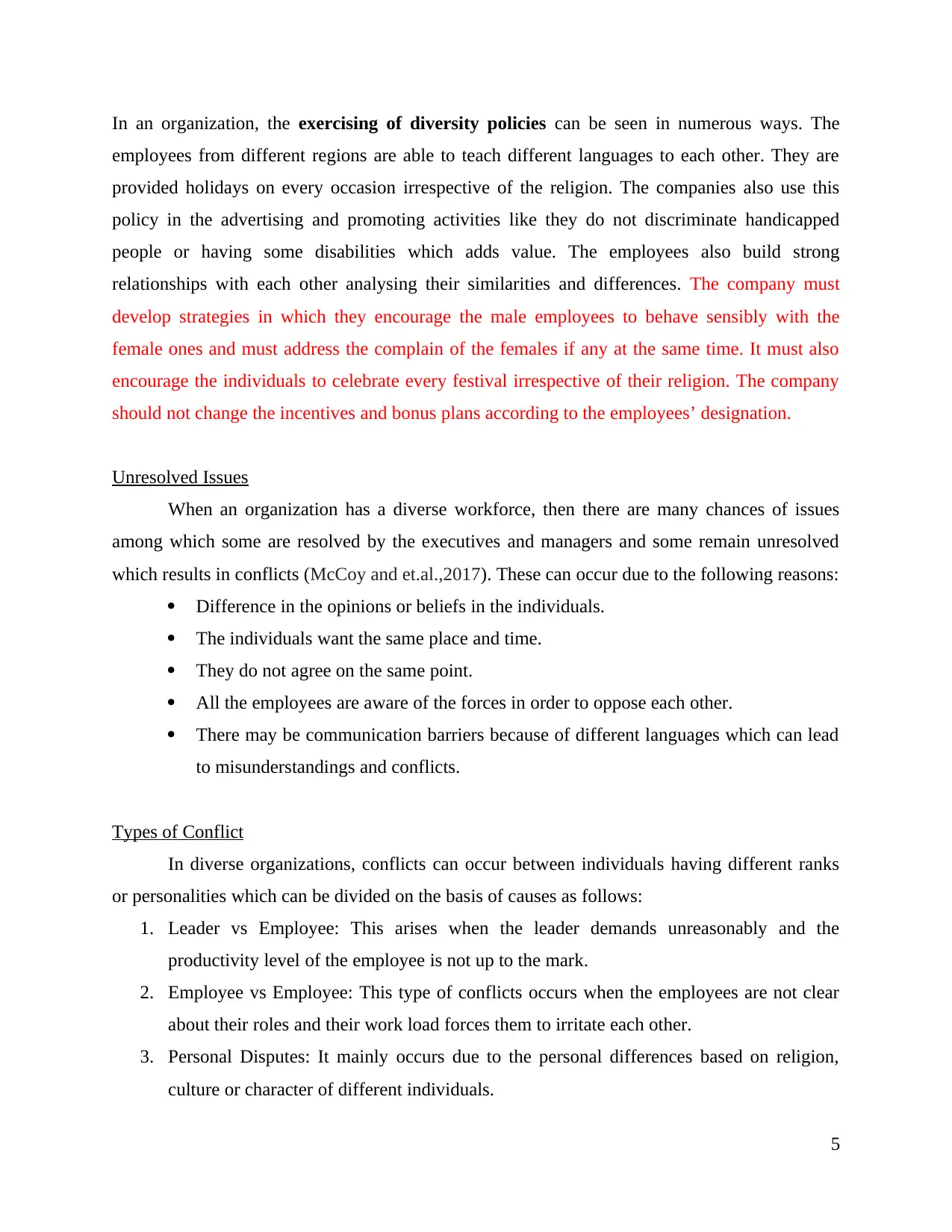
In an organization, the exercising of diversity policies can be seen in numerous ways. The
employees from different regions are able to teach different languages to each other. They are
provided holidays on every occasion irrespective of the religion. The companies also use this
policy in the advertising and promoting activities like they do not discriminate handicapped
people or having some disabilities which adds value. The employees also build strong
relationships with each other analysing their similarities and differences. The company must
develop strategies in which they encourage the male employees to behave sensibly with the
female ones and must address the complain of the females if any at the same time. It must also
encourage the individuals to celebrate every festival irrespective of their religion. The company
should not change the incentives and bonus plans according to the employees’ designation.
Unresolved Issues
When an organization has a diverse workforce, then there are many chances of issues
among which some are resolved by the executives and managers and some remain unresolved
which results in conflicts (McCoy and et.al.,2017). These can occur due to the following reasons:
Difference in the opinions or beliefs in the individuals.
The individuals want the same place and time.
They do not agree on the same point.
All the employees are aware of the forces in order to oppose each other.
There may be communication barriers because of different languages which can lead
to misunderstandings and conflicts.
Types of Conflict
In diverse organizations, conflicts can occur between individuals having different ranks
or personalities which can be divided on the basis of causes as follows:
1. Leader vs Employee: This arises when the leader demands unreasonably and the
productivity level of the employee is not up to the mark.
2. Employee vs Employee: This type of conflicts occurs when the employees are not clear
about their roles and their work load forces them to irritate each other.
3. Personal Disputes: It mainly occurs due to the personal differences based on religion,
culture or character of different individuals.
5
employees from different regions are able to teach different languages to each other. They are
provided holidays on every occasion irrespective of the religion. The companies also use this
policy in the advertising and promoting activities like they do not discriminate handicapped
people or having some disabilities which adds value. The employees also build strong
relationships with each other analysing their similarities and differences. The company must
develop strategies in which they encourage the male employees to behave sensibly with the
female ones and must address the complain of the females if any at the same time. It must also
encourage the individuals to celebrate every festival irrespective of their religion. The company
should not change the incentives and bonus plans according to the employees’ designation.
Unresolved Issues
When an organization has a diverse workforce, then there are many chances of issues
among which some are resolved by the executives and managers and some remain unresolved
which results in conflicts (McCoy and et.al.,2017). These can occur due to the following reasons:
Difference in the opinions or beliefs in the individuals.
The individuals want the same place and time.
They do not agree on the same point.
All the employees are aware of the forces in order to oppose each other.
There may be communication barriers because of different languages which can lead
to misunderstandings and conflicts.
Types of Conflict
In diverse organizations, conflicts can occur between individuals having different ranks
or personalities which can be divided on the basis of causes as follows:
1. Leader vs Employee: This arises when the leader demands unreasonably and the
productivity level of the employee is not up to the mark.
2. Employee vs Employee: This type of conflicts occurs when the employees are not clear
about their roles and their work load forces them to irritate each other.
3. Personal Disputes: It mainly occurs due to the personal differences based on religion,
culture or character of different individuals.
5
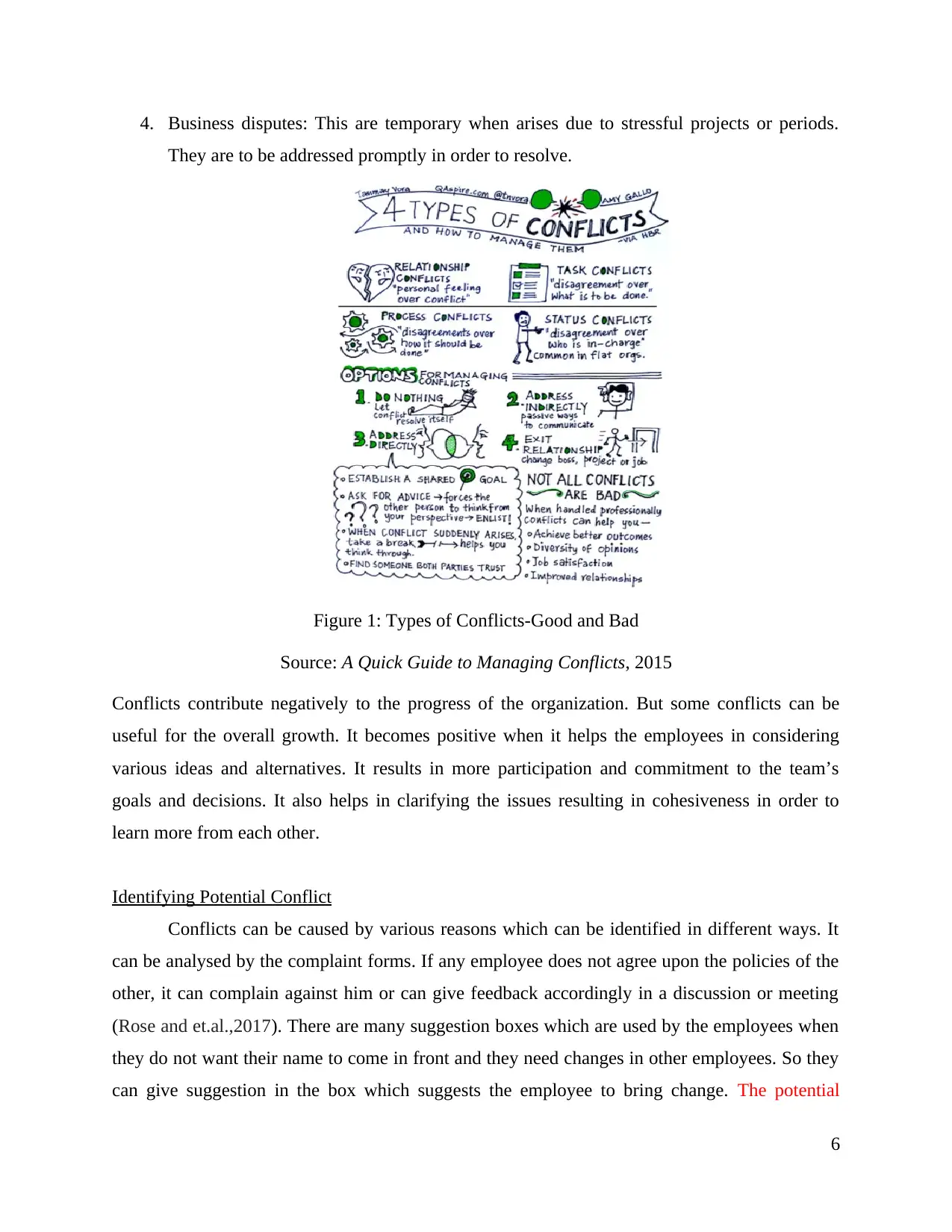
4. Business disputes: This are temporary when arises due to stressful projects or periods.
They are to be addressed promptly in order to resolve.
Figure 1: Types of Conflicts-Good and Bad
Source: A Quick Guide to Managing Conflicts, 2015
Conflicts contribute negatively to the progress of the organization. But some conflicts can be
useful for the overall growth. It becomes positive when it helps the employees in considering
various ideas and alternatives. It results in more participation and commitment to the team’s
goals and decisions. It also helps in clarifying the issues resulting in cohesiveness in order to
learn more from each other.
Identifying Potential Conflict
Conflicts can be caused by various reasons which can be identified in different ways. It
can be analysed by the complaint forms. If any employee does not agree upon the policies of the
other, it can complain against him or can give feedback accordingly in a discussion or meeting
(Rose and et.al.,2017). There are many suggestion boxes which are used by the employees when
they do not want their name to come in front and they need changes in other employees. So they
can give suggestion in the box which suggests the employee to bring change. The potential
6
They are to be addressed promptly in order to resolve.
Figure 1: Types of Conflicts-Good and Bad
Source: A Quick Guide to Managing Conflicts, 2015
Conflicts contribute negatively to the progress of the organization. But some conflicts can be
useful for the overall growth. It becomes positive when it helps the employees in considering
various ideas and alternatives. It results in more participation and commitment to the team’s
goals and decisions. It also helps in clarifying the issues resulting in cohesiveness in order to
learn more from each other.
Identifying Potential Conflict
Conflicts can be caused by various reasons which can be identified in different ways. It
can be analysed by the complaint forms. If any employee does not agree upon the policies of the
other, it can complain against him or can give feedback accordingly in a discussion or meeting
(Rose and et.al.,2017). There are many suggestion boxes which are used by the employees when
they do not want their name to come in front and they need changes in other employees. So they
can give suggestion in the box which suggests the employee to bring change. The potential
6
⊘ This is a preview!⊘
Do you want full access?
Subscribe today to unlock all pages.

Trusted by 1+ million students worldwide
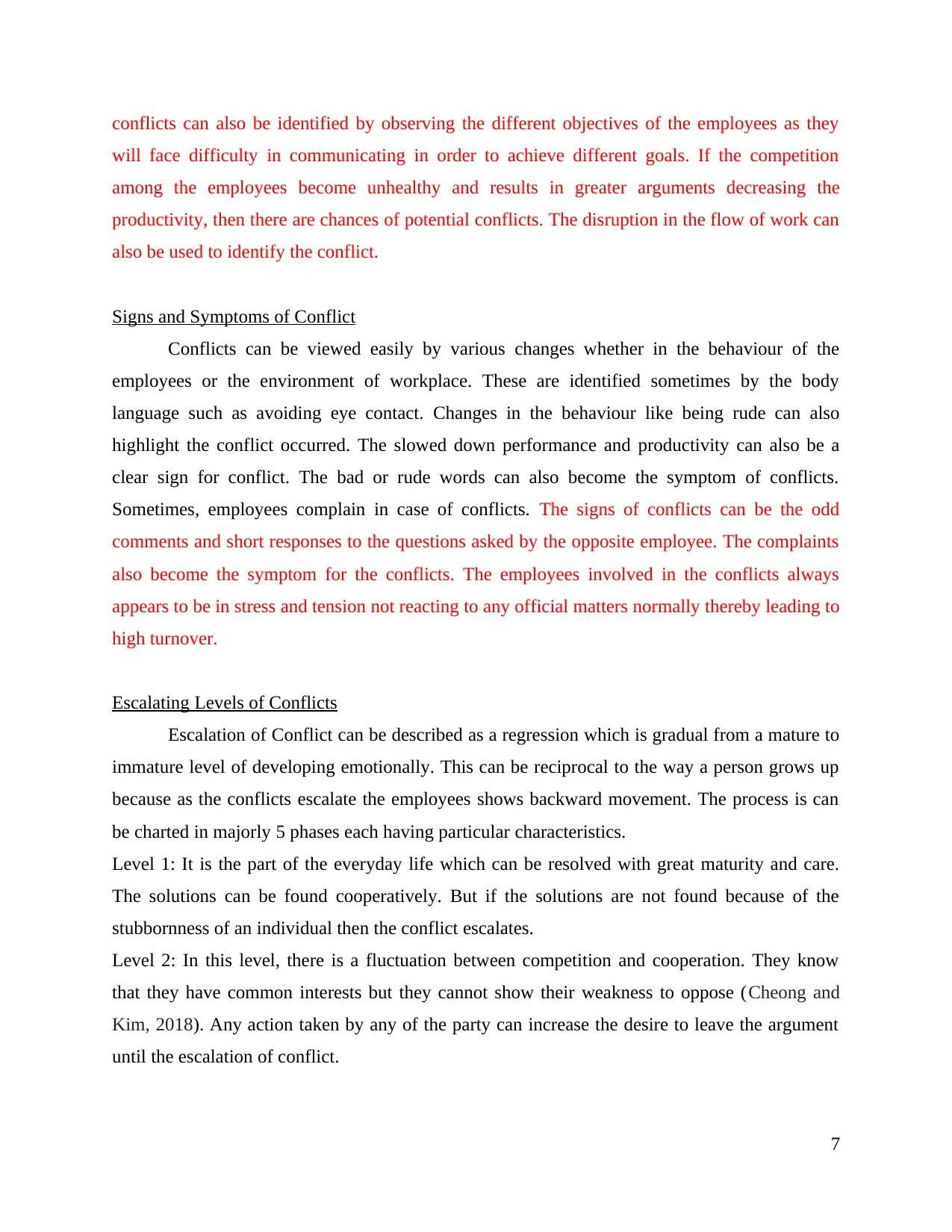
conflicts can also be identified by observing the different objectives of the employees as they
will face difficulty in communicating in order to achieve different goals. If the competition
among the employees become unhealthy and results in greater arguments decreasing the
productivity, then there are chances of potential conflicts. The disruption in the flow of work can
also be used to identify the conflict.
Signs and Symptoms of Conflict
Conflicts can be viewed easily by various changes whether in the behaviour of the
employees or the environment of workplace. These are identified sometimes by the body
language such as avoiding eye contact. Changes in the behaviour like being rude can also
highlight the conflict occurred. The slowed down performance and productivity can also be a
clear sign for conflict. The bad or rude words can also become the symptom of conflicts.
Sometimes, employees complain in case of conflicts. The signs of conflicts can be the odd
comments and short responses to the questions asked by the opposite employee. The complaints
also become the symptom for the conflicts. The employees involved in the conflicts always
appears to be in stress and tension not reacting to any official matters normally thereby leading to
high turnover.
Escalating Levels of Conflicts
Escalation of Conflict can be described as a regression which is gradual from a mature to
immature level of developing emotionally. This can be reciprocal to the way a person grows up
because as the conflicts escalate the employees shows backward movement. The process is can
be charted in majorly 5 phases each having particular characteristics.
Level 1: It is the part of the everyday life which can be resolved with great maturity and care.
The solutions can be found cooperatively. But if the solutions are not found because of the
stubbornness of an individual then the conflict escalates.
Level 2: In this level, there is a fluctuation between competition and cooperation. They know
that they have common interests but they cannot show their weakness to oppose (Cheong and
Kim, 2018). Any action taken by any of the party can increase the desire to leave the argument
until the escalation of conflict.
7
will face difficulty in communicating in order to achieve different goals. If the competition
among the employees become unhealthy and results in greater arguments decreasing the
productivity, then there are chances of potential conflicts. The disruption in the flow of work can
also be used to identify the conflict.
Signs and Symptoms of Conflict
Conflicts can be viewed easily by various changes whether in the behaviour of the
employees or the environment of workplace. These are identified sometimes by the body
language such as avoiding eye contact. Changes in the behaviour like being rude can also
highlight the conflict occurred. The slowed down performance and productivity can also be a
clear sign for conflict. The bad or rude words can also become the symptom of conflicts.
Sometimes, employees complain in case of conflicts. The signs of conflicts can be the odd
comments and short responses to the questions asked by the opposite employee. The complaints
also become the symptom for the conflicts. The employees involved in the conflicts always
appears to be in stress and tension not reacting to any official matters normally thereby leading to
high turnover.
Escalating Levels of Conflicts
Escalation of Conflict can be described as a regression which is gradual from a mature to
immature level of developing emotionally. This can be reciprocal to the way a person grows up
because as the conflicts escalate the employees shows backward movement. The process is can
be charted in majorly 5 phases each having particular characteristics.
Level 1: It is the part of the everyday life which can be resolved with great maturity and care.
The solutions can be found cooperatively. But if the solutions are not found because of the
stubbornness of an individual then the conflict escalates.
Level 2: In this level, there is a fluctuation between competition and cooperation. They know
that they have common interests but they cannot show their weakness to oppose (Cheong and
Kim, 2018). Any action taken by any of the party can increase the desire to leave the argument
until the escalation of conflict.
7
Paraphrase This Document
Need a fresh take? Get an instant paraphrase of this document with our AI Paraphraser

Level 3: This is the level of concrete actions in which the opposing parties lose the hope to find a
common solution of the conflict. Many discussions are made but none of the party becomes
ready to solve the issue but pressures other to do the same.
Level 4: In this level, because of escalation, the parties behave like children. They are not
capable of considering the thoughts of the opposite party. They feel restricted and cannot escape.
Level 5: This is the level of highest loss as it involves the loss of Sacred values, convictions and
morals. It totally works on perceptions. The matter can reach to the courtroom also because both
the parties stress on forcing each other.
Dangerous Conflict Situations
Immediate actions must be taken in order to resolve the conflicts because sometimes the
conflicts can reach the level to reach the courtroom. The manager or the superior authority must
take the decision if anger is required, then also they must become strict and takes the firm
decision because if the conflict is exposed outside the company, it will destroy its goodwill and
image in the market.
Impact of Conflict
It plays a major role in disturbing the environment of the workplace and also disturbs the
mental stability of the workforce. This makes the performance of the employees inefficient and
also decreases the productivity. The conflicts if reach higher level can harm the reputation and
image of the company violating many laws and regulations.
It also decreases the customer base by reducing the loyalty among them. It also breaks the trust
among the employees and the leaders.
Conflict Management
The process of Conflict Resolution contains various processes within it. The managers
and the executives must play a major role in it. First need is to identify the conflict whether it is
to be noticed or not because the senior authority must know about everything. Then comes the
need to analyse the reason of the conflict and the parties involves in it along with being calm and
tactful (Chenhall, Hall and Smith, 2016). It must be followed by finding the option quickly for
conflict about the alternative which can be used to solve the problem instead of conflict. Then
8
common solution of the conflict. Many discussions are made but none of the party becomes
ready to solve the issue but pressures other to do the same.
Level 4: In this level, because of escalation, the parties behave like children. They are not
capable of considering the thoughts of the opposite party. They feel restricted and cannot escape.
Level 5: This is the level of highest loss as it involves the loss of Sacred values, convictions and
morals. It totally works on perceptions. The matter can reach to the courtroom also because both
the parties stress on forcing each other.
Dangerous Conflict Situations
Immediate actions must be taken in order to resolve the conflicts because sometimes the
conflicts can reach the level to reach the courtroom. The manager or the superior authority must
take the decision if anger is required, then also they must become strict and takes the firm
decision because if the conflict is exposed outside the company, it will destroy its goodwill and
image in the market.
Impact of Conflict
It plays a major role in disturbing the environment of the workplace and also disturbs the
mental stability of the workforce. This makes the performance of the employees inefficient and
also decreases the productivity. The conflicts if reach higher level can harm the reputation and
image of the company violating many laws and regulations.
It also decreases the customer base by reducing the loyalty among them. It also breaks the trust
among the employees and the leaders.
Conflict Management
The process of Conflict Resolution contains various processes within it. The managers
and the executives must play a major role in it. First need is to identify the conflict whether it is
to be noticed or not because the senior authority must know about everything. Then comes the
need to analyse the reason of the conflict and the parties involves in it along with being calm and
tactful (Chenhall, Hall and Smith, 2016). It must be followed by finding the option quickly for
conflict about the alternative which can be used to solve the problem instead of conflict. Then
8
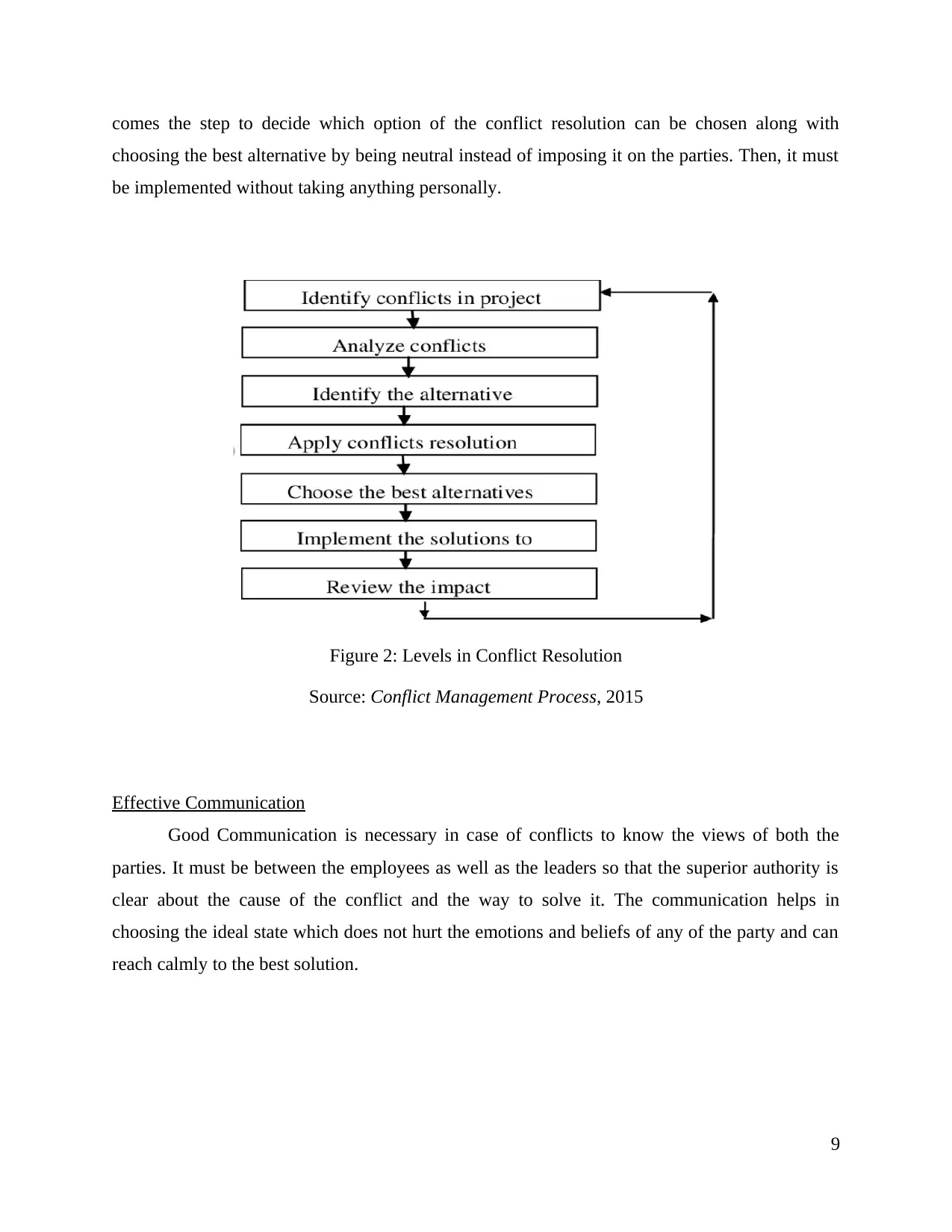
comes the step to decide which option of the conflict resolution can be chosen along with
choosing the best alternative by being neutral instead of imposing it on the parties. Then, it must
be implemented without taking anything personally.
Figure 2: Levels in Conflict Resolution
Source: Conflict Management Process, 2015
Effective Communication
Good Communication is necessary in case of conflicts to know the views of both the
parties. It must be between the employees as well as the leaders so that the superior authority is
clear about the cause of the conflict and the way to solve it. The communication helps in
choosing the ideal state which does not hurt the emotions and beliefs of any of the party and can
reach calmly to the best solution.
9
choosing the best alternative by being neutral instead of imposing it on the parties. Then, it must
be implemented without taking anything personally.
Figure 2: Levels in Conflict Resolution
Source: Conflict Management Process, 2015
Effective Communication
Good Communication is necessary in case of conflicts to know the views of both the
parties. It must be between the employees as well as the leaders so that the superior authority is
clear about the cause of the conflict and the way to solve it. The communication helps in
choosing the ideal state which does not hurt the emotions and beliefs of any of the party and can
reach calmly to the best solution.
9
⊘ This is a preview!⊘
Do you want full access?
Subscribe today to unlock all pages.

Trusted by 1+ million students worldwide
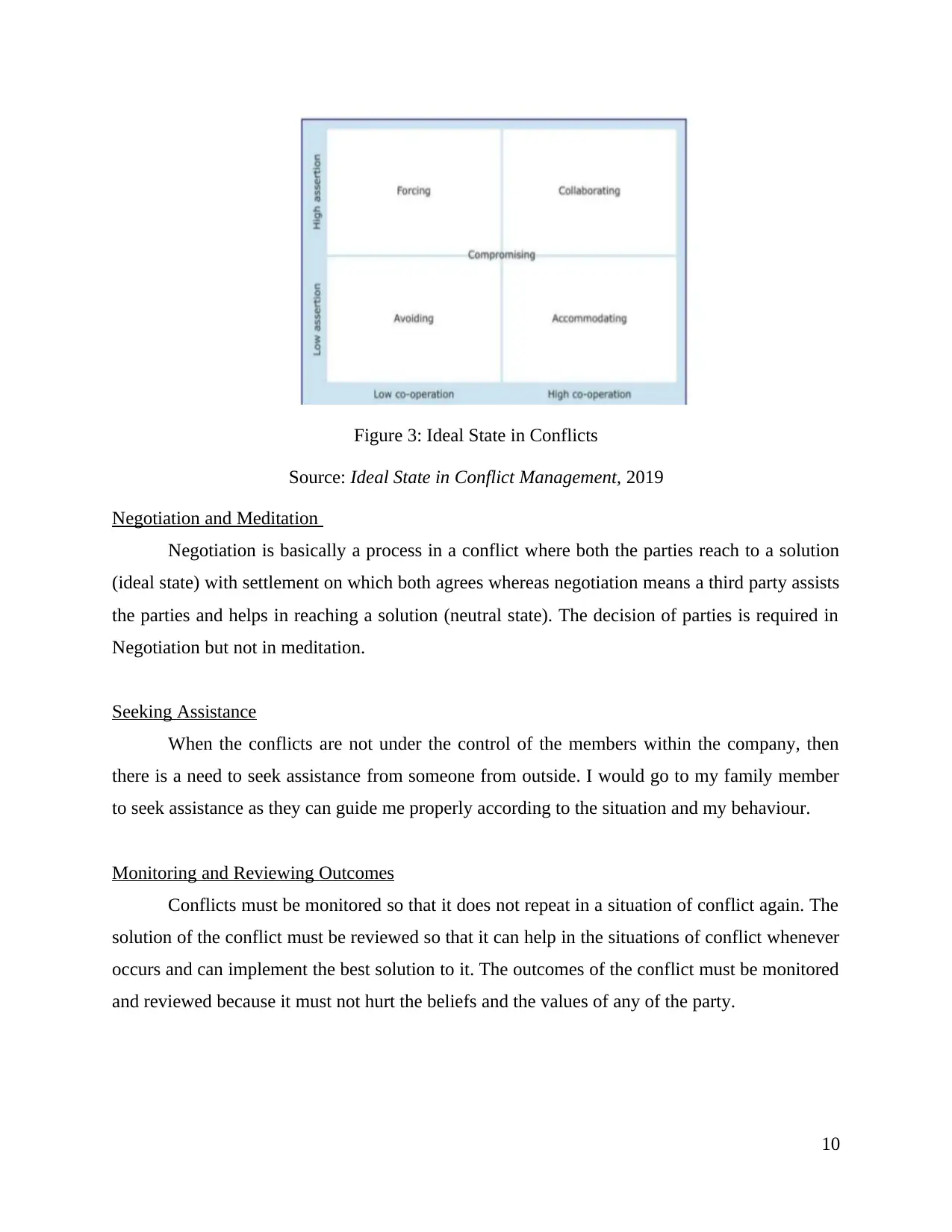
Figure 3: Ideal State in Conflicts
Source: Ideal State in Conflict Management, 2019
Negotiation and Meditation
Negotiation is basically a process in a conflict where both the parties reach to a solution
(ideal state) with settlement on which both agrees whereas negotiation means a third party assists
the parties and helps in reaching a solution (neutral state). The decision of parties is required in
Negotiation but not in meditation.
Seeking Assistance
When the conflicts are not under the control of the members within the company, then
there is a need to seek assistance from someone from outside. I would go to my family member
to seek assistance as they can guide me properly according to the situation and my behaviour.
Monitoring and Reviewing Outcomes
Conflicts must be monitored so that it does not repeat in a situation of conflict again. The
solution of the conflict must be reviewed so that it can help in the situations of conflict whenever
occurs and can implement the best solution to it. The outcomes of the conflict must be monitored
and reviewed because it must not hurt the beliefs and the values of any of the party.
10
Source: Ideal State in Conflict Management, 2019
Negotiation and Meditation
Negotiation is basically a process in a conflict where both the parties reach to a solution
(ideal state) with settlement on which both agrees whereas negotiation means a third party assists
the parties and helps in reaching a solution (neutral state). The decision of parties is required in
Negotiation but not in meditation.
Seeking Assistance
When the conflicts are not under the control of the members within the company, then
there is a need to seek assistance from someone from outside. I would go to my family member
to seek assistance as they can guide me properly according to the situation and my behaviour.
Monitoring and Reviewing Outcomes
Conflicts must be monitored so that it does not repeat in a situation of conflict again. The
solution of the conflict must be reviewed so that it can help in the situations of conflict whenever
occurs and can implement the best solution to it. The outcomes of the conflict must be monitored
and reviewed because it must not hurt the beliefs and the values of any of the party.
10
Paraphrase This Document
Need a fresh take? Get an instant paraphrase of this document with our AI Paraphraser

Record Keeping
The senior authority of the company must keep the record of the employees who are
involved in the conflict till the employee participates in the operations and functions. It must also
keep some identity proofs for later use when the effects come in play. It must be confidential and
need not to be disclosed.
CONCLUSION
The above report discussed all the aspects of the diversity including legislations,
strategies, impacts in an organization along with describing its major problem i.e., conflicts. It
also evaluated the conflict’s causes, solutions, types, levels, situations, impact, ways to manage,
review, monitor and many more. Therefore, it gives a clear idea about the diverse organizations
and the conflicts occurring in them.
11
The senior authority of the company must keep the record of the employees who are
involved in the conflict till the employee participates in the operations and functions. It must also
keep some identity proofs for later use when the effects come in play. It must be confidential and
need not to be disclosed.
CONCLUSION
The above report discussed all the aspects of the diversity including legislations,
strategies, impacts in an organization along with describing its major problem i.e., conflicts. It
also evaluated the conflict’s causes, solutions, types, levels, situations, impact, ways to manage,
review, monitor and many more. Therefore, it gives a clear idea about the diverse organizations
and the conflicts occurring in them.
11
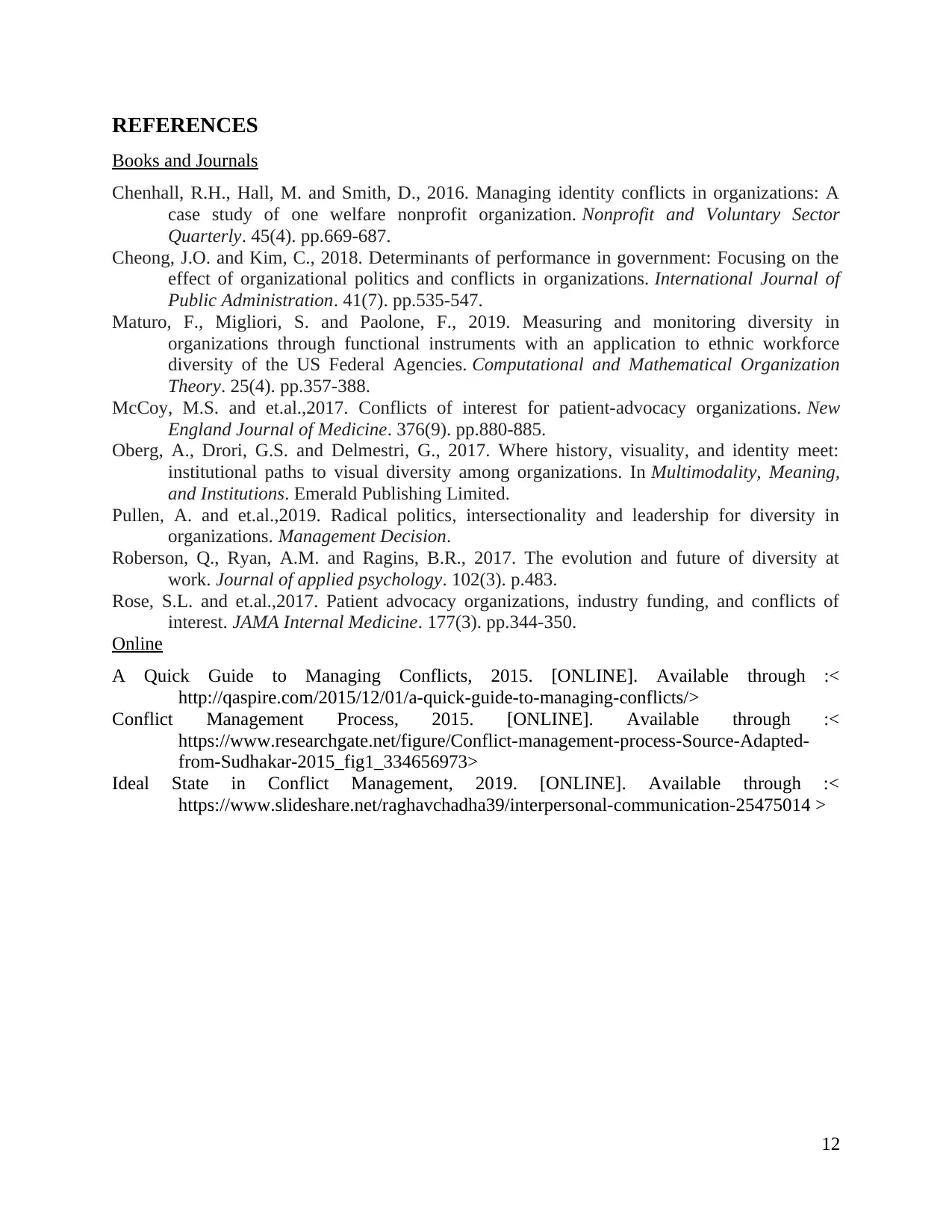
REFERENCES
Books and Journals
Chenhall, R.H., Hall, M. and Smith, D., 2016. Managing identity conflicts in organizations: A
case study of one welfare nonprofit organization. Nonprofit and Voluntary Sector
Quarterly. 45(4). pp.669-687.
Cheong, J.O. and Kim, C., 2018. Determinants of performance in government: Focusing on the
effect of organizational politics and conflicts in organizations. International Journal of
Public Administration. 41(7). pp.535-547.
Maturo, F., Migliori, S. and Paolone, F., 2019. Measuring and monitoring diversity in
organizations through functional instruments with an application to ethnic workforce
diversity of the US Federal Agencies. Computational and Mathematical Organization
Theory. 25(4). pp.357-388.
McCoy, M.S. and et.al.,2017. Conflicts of interest for patient-advocacy organizations. New
England Journal of Medicine. 376(9). pp.880-885.
Oberg, A., Drori, G.S. and Delmestri, G., 2017. Where history, visuality, and identity meet:
institutional paths to visual diversity among organizations. In Multimodality, Meaning,
and Institutions. Emerald Publishing Limited.
Pullen, A. and et.al.,2019. Radical politics, intersectionality and leadership for diversity in
organizations. Management Decision.
Roberson, Q., Ryan, A.M. and Ragins, B.R., 2017. The evolution and future of diversity at
work. Journal of applied psychology. 102(3). p.483.
Rose, S.L. and et.al.,2017. Patient advocacy organizations, industry funding, and conflicts of
interest. JAMA Internal Medicine. 177(3). pp.344-350.
Online
A Quick Guide to Managing Conflicts, 2015. [ONLINE]. Available through :<
http://qaspire.com/2015/12/01/a-quick-guide-to-managing-conflicts/>
Conflict Management Process, 2015. [ONLINE]. Available through :<
https://www.researchgate.net/figure/Conflict-management-process-Source-Adapted-
from-Sudhakar-2015_fig1_334656973>
Ideal State in Conflict Management, 2019. [ONLINE]. Available through :<
https://www.slideshare.net/raghavchadha39/interpersonal-communication-25475014 >
12
Books and Journals
Chenhall, R.H., Hall, M. and Smith, D., 2016. Managing identity conflicts in organizations: A
case study of one welfare nonprofit organization. Nonprofit and Voluntary Sector
Quarterly. 45(4). pp.669-687.
Cheong, J.O. and Kim, C., 2018. Determinants of performance in government: Focusing on the
effect of organizational politics and conflicts in organizations. International Journal of
Public Administration. 41(7). pp.535-547.
Maturo, F., Migliori, S. and Paolone, F., 2019. Measuring and monitoring diversity in
organizations through functional instruments with an application to ethnic workforce
diversity of the US Federal Agencies. Computational and Mathematical Organization
Theory. 25(4). pp.357-388.
McCoy, M.S. and et.al.,2017. Conflicts of interest for patient-advocacy organizations. New
England Journal of Medicine. 376(9). pp.880-885.
Oberg, A., Drori, G.S. and Delmestri, G., 2017. Where history, visuality, and identity meet:
institutional paths to visual diversity among organizations. In Multimodality, Meaning,
and Institutions. Emerald Publishing Limited.
Pullen, A. and et.al.,2019. Radical politics, intersectionality and leadership for diversity in
organizations. Management Decision.
Roberson, Q., Ryan, A.M. and Ragins, B.R., 2017. The evolution and future of diversity at
work. Journal of applied psychology. 102(3). p.483.
Rose, S.L. and et.al.,2017. Patient advocacy organizations, industry funding, and conflicts of
interest. JAMA Internal Medicine. 177(3). pp.344-350.
Online
A Quick Guide to Managing Conflicts, 2015. [ONLINE]. Available through :<
http://qaspire.com/2015/12/01/a-quick-guide-to-managing-conflicts/>
Conflict Management Process, 2015. [ONLINE]. Available through :<
https://www.researchgate.net/figure/Conflict-management-process-Source-Adapted-
from-Sudhakar-2015_fig1_334656973>
Ideal State in Conflict Management, 2019. [ONLINE]. Available through :<
https://www.slideshare.net/raghavchadha39/interpersonal-communication-25475014 >
12
⊘ This is a preview!⊘
Do you want full access?
Subscribe today to unlock all pages.

Trusted by 1+ million students worldwide
1 out of 13
Related Documents
Your All-in-One AI-Powered Toolkit for Academic Success.
+13062052269
info@desklib.com
Available 24*7 on WhatsApp / Email
![[object Object]](/_next/static/media/star-bottom.7253800d.svg)
Unlock your academic potential
Copyright © 2020–2025 A2Z Services. All Rights Reserved. Developed and managed by ZUCOL.





